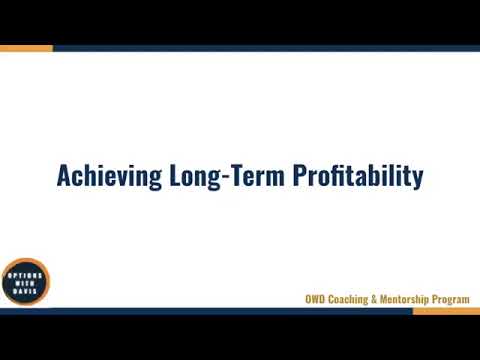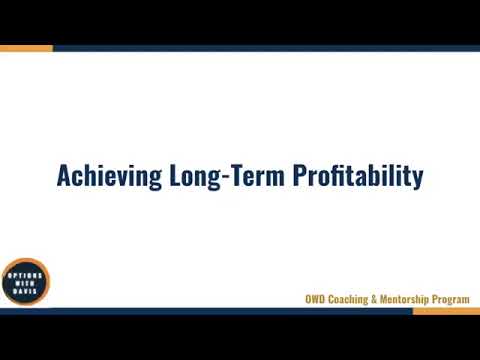In this video titled “1-4 Achieving Long Term Profitability,” we’ll be discussing the importance of achieving long-term profitability in options trading. We’ll delve into the advantages of selling options due to overstated volatility and the differences in losing streaks between debit and credit strategies. We’ll also explore how the true probability in trading strategies is reached through a large sample size and why trading strategies with high win rates take time to reach their true probability. We’ll emphasize the significance of taking quality setups and avoiding the temptation to force trades in order to ensure long-term profitability.
In this video, we’ll touch upon the topic of achieving long-term profitability in options trading. It’s crucial to sustain profitability over time instead of just making short-term profits. Selling options can give you an edge due to overstated volatility, leading to higher win rates. However, it’s important to note that debit strategies may have longer losing streaks compared to credit strategies. Understanding the concept of true probability and how it is achieved over a large sample size is essential for successful trading. We’ll also discuss the significance of patience, taking quality setups, and not forcing trades to ensure consistent profitability in the long run.
Achieving Long-term Profitability in Options Trading
Understanding Options Trading
In order to achieve long-term profitability in options trading, it’s important to have a solid understanding of how options work. Options are financial derivatives that give you the right, but not the obligation, to buy or sell an underlying asset at a predetermined price within a specified time period. The two main types of options are calls and puts. A call option gives you the right to buy the underlying asset, while a put option gives you the right to sell the underlying asset.
The Benefits of Selling Options
One of the keys to long-term profitability in options trading is the strategy of selling options. Selling options allows you to collect premium income upfront, which can lead to consistent profits over time. When you sell options, you act as the “insurance company” for the buyer of the option, taking on the risk of potentially having to buy or sell the underlying asset at the predetermined price. By selling options, you can take advantage of overstated volatility, which means that options tend to be priced higher than they should be based on historical volatility. This gives you an edge in the market and increases your chances of success.
Debit Strategies vs. Credit Strategies
When it comes to options trading, there are two main types of strategies: debit strategies and credit strategies. Debit strategies involve buying options, which can be more expensive upfront but offer unlimited profit potential. Credit strategies involve selling options, which allows you to collect premium income upfront but comes with limited profit potential. In general, credit strategies are often preferred for achieving long-term profitability due to their higher win rates and shorter losing streaks. Debit strategies, on the other hand, may have longer losing streaks and require a larger sample size to reach their true probability.
The Importance of a Large Sample Size
To truly understand the probability and profitability of a trading strategy, it’s important to have a large sample size. This means making a sufficient number of trades to account for statistical variations and reach the true probability of success. Just as flipping a coin 10 times may give you a skewed perspective of the true probability, taking a small number of trades may lead you to incorrect conclusions about the effectiveness of a trading strategy. By tracking and analyzing a larger sample size of trades, you can get a more accurate picture of the win rate and overall performance of your strategy.

High Win Rates and True Probability
While high win rates are often desirable in options trading, it’s important to understand that they will only reach their true probability over a large sample size. A trading strategy with an 80% win rate, for example, may not achieve that win rate consistently in the short term. It’s only by taking a sufficient number of trades that you can start to see the win rate converge towards its true probability. This is why it’s essential to have patience and avoid forcing trades just to reach a certain number of trades. Focus on quality setups and let the true probability of your strategy play out over time.
Taking Quality Setups
One of the key factors in achieving long-term profitability is taking quality setups. Instead of forcing trades or taking subpar setups, it’s important to wait for high-probability opportunities to present themselves. This means looking for setups with clear entry and exit criteria, solid risk-reward ratios, and a high probability of success. By being selective and patient, you can increase your chances of success and avoid unnecessary losses.
Avoiding Forced Trades
In the pursuit of achieving long-term profitability, it’s crucial to avoid forcing trades. When you force a trade, you deviate from your trading plan and take on unnecessary risks. Instead of chasing trades or trying to make up for losses, it’s important to stick to your strategy and only take trades that meet your criteria. By avoiding forced trades, you can maintain discipline and increase your chances of long-term success.
Implementing Risk Management Strategies
Risk management is another vital aspect of achieving long-term profitability in options trading. By implementing risk management strategies, you can protect your capital and minimize losses. This includes setting stop-loss orders to limit potential losses on trades, diversifying your portfolio to spread risk, and properly sizing your positions to avoid overleveraging. By effectively managing risk, you can protect your capital and increase your chances of long-term profitability.
Building a Diversified Portfolio
In options trading, it’s important to not put all your eggs in one basket. Building a diversified portfolio can help spread risk and increase the chances of consistent profits over time. By diversifying across different underlying assets, industries, and strategies, you can reduce the impact of any single trade or market event. This can help protect your portfolio and increase your chances of long-term profitability.
Continuous Learning and Adaptation
An essential part of achieving long-term profitability in options trading is continuous learning and adaptation. Markets are constantly changing, and what may have worked in the past may not work in the future. By staying updated on market trends, studying successful traders, and continuously improving your knowledge and skills, you can adapt your strategies to changing market conditions. This ongoing learning process will help you stay ahead of the game and increase your chances of long-term profitability.
Conclusion
Achieving long-term profitability in options trading requires a combination of understanding options, utilizing selling strategies, managing risk, and continuously learning and adapting. By focusing on quality setups, avoiding forced trades, implementing risk management strategies, and building a diversified portfolio, you can increase your chances of consistent profits over time. Remember, true probability is reached over a large sample size, so be patient and stay disciplined in your trading approach. With the right mindset, knowledge, and skills, you can achieve long-term profitability in options trading.
